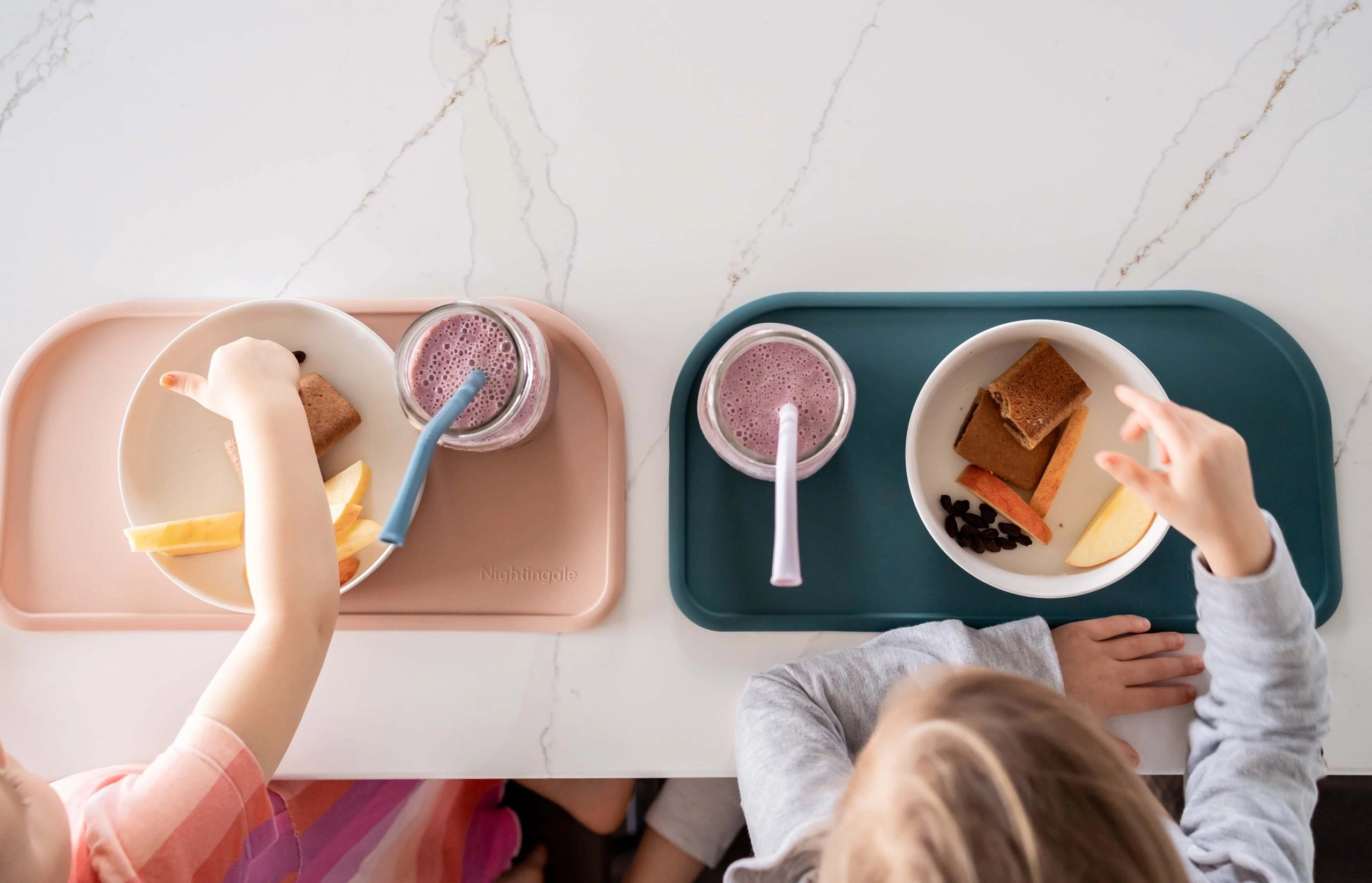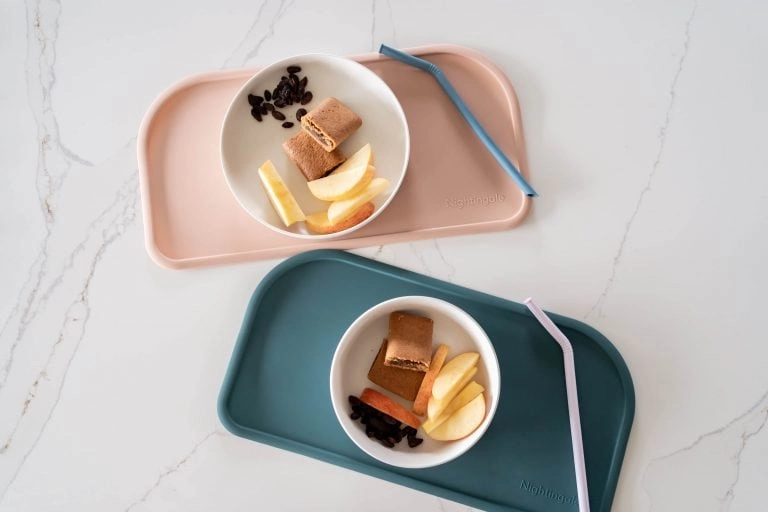Guide To Buying Placemat For Kids: 7 Important Factors You Should Consider
On the go? Click below to listen to the blog here 👇
Before kids: Have you ever thought about why people need to buy placemat for kids?
Let’s face it: toddlers are messy, and there is no way of telling what will happen at your next meal so you better get ready for anything! Mealtimes are better when there is not a huge mess to clean up. That’s why many parents choose to use placemats to help protect the surface from spilled food and drinks.
When shopping for placemats, there are a few things to consider such as material, durability, size, and ease of cleaning. We want you to feel confident in knowing that when the inevitable mess happens, there is a placemat out there that has your back (or front).
We have compiled this list of questions to ask yourself before buying one just for you or as a gift for someone else who could do with a little less post-meal clean ups.
View our full guide:Best placemats for kids
Is a placemat necessary?
The short answer is YES. My daughter, who is 4 at the time of writing, loves eating at the table with us. However, as she often spills her food and drink, we would always end up cleaning the table and the floor after each meal. Most of the crumbs just seem to land around the table, on the floor… basically everywhere except on her plate.
Having a placemat not only can help protect the table surface, but it would also help your child establish a good routine during mealtime and allow them to enjoy food easier. Since we introduced placemats to our kids, they have quickly become an essential item for mealtime, whether at home or when dining out.

Yeah Baby Goods placemat for the ANTILOP IKEA highchair table
Buying Criteria of Placemat for Kids
Of course, cost will play a role in determining what placemat to buy, but there are four main things to consider when purchasing placemats used for kids. These four things include the material used to make the mat, how easy the mat is to clean, the mat’s size, and if the mat will slip and slide while in use.
A great placemat does not have to cost a lot, but it does need to meet the criteria of a busy family and stand the test of time.
Material
Placemats for kids can be found in a variety of different materials. Fabric, plastic, and silicone are a few examples of materials used to make placemats. There is a big difference between each of these materials, and understanding the differences in each of these popular materials is key to choosing the safest and best product for your family.
Ease of Cleaning
After a few cleanings, some placemats can already look as if they need replacing. They get stained, torn, or lose their new look.
No one wants to have to keep replacing old-looking placemats. That is one reason it is essential to consider the ease of cleaning when it comes to these mats. If cleaning them becomes a chore, then what is the point.
Parents want mats that can be wiped off, rinsed off, or just dropped off into the laundry. Dishwasher-friendly placemats are even better because they take less time and effort to clean and care for.
Size
The size of the placemat you need will depend on what area you are trying to cover, but your placemat needs to be able to fit on any flat area you are looking to protect. Some mats are made to be shared by two children buy we find that individual placemats work.
Kids are always moving and touching and not always the best at sharing the same areas. When it comes to ease of use, we find that placemats size matters, and individual mats work best for multiple kids, each with different needs.
Suction/Anti-slip
Tabletop mats used by kids need to be able to stay in one place during use. Kids are movers, and movers at meal and playtime can get messy.
To reduce the mess, some placemats for kids are made suction to the table and provide an anti-slip place that is user friendly for the busies child. A flat silicone placemat will give the best protection to the area and not cause any damage when removed for cleaning.
What Are the Different Types of Placemat?
Like we said before, there are many types of placemats to choose from, but the most popular are those made from fabric, plastic, and silicone. Other options include paper, Vinyl, and even some with adhesive backings.
While disposable covers may seem like an easy clean-up option, this is not an environmentally friendly option, and they are not always as resistant as you would want them to be.
Fabric
Placemats can be made of various fabrics, such as cotton, polyester, and linen. Cloth mats are a popular option because they can be used as a decorative piece in your dining room, but these are often removed from the table so they do not get dirty or stained.
Fabric can be easy to wash, but no everyone enjoys having the extra laundry every day, making fabric placemats a hassle. The decorative value of fabric mats is fun, but the material may not protect against spills as many parents would hope.
Plastic (Polypropylene PP)
Many plastic placemats use fillers to producing products. Some chemical fillers that manufacturers routinely use are BPA, phthalates, and nitrate, which can damage the environment and have been known to cause health problems in people exposed to too many of these chemicals.
According to the FDA, it is rare for problems from low-doses of BPA, or other chemical fillers, to cause a risk to human health, but some experts think this should be studied further. More recent regulations from the FDA require baby products to be BPA-free.
Platinum Silicone VS Regular Food Grade Silicone?
Food-grade silicone is high-quality silicone used in many kitchen utensils that we use each day. Compared to other materials, silicone is waterproof, flexible and more environmentally-friendly. However, this type of silicone can also be subject to smell and stiffness after extended use.
Platinum silicone (which is also food-grade) is more durable. On top of that, products made with platinum silicone are generally softer, do not have chemical smells or get stiff over time, making them ideal for babies.
It is important to note that both regular silicone and platinum silicone are great choices, but you need to make sure the placemat you are buying are made of 100% silicone and not mixed with other materials.
Disposable vs Reusable Placemat?
There are pros and cons associated with both disposable and reusable placemats, and parents trying to decide what type of placemats to use may want to consider which would be a better option for their family.
|
|
Disposable |
Reusable |
|---|---|---|
|
Convenience |
Convenient: can be used anywhere. |
– PVC: Not easy to pack – Silicone: can be rolled up |
|
Clean-up |
– Zero: Throw away once done – Easy to rip: might end up with a bigger mess |
Minimal: Wipe clean/Dishwasher safe |
|
Environmentally-friendly |
Not environmentally friendly. Create waste that may not end up being recycled. |
– PVC: Not so much when disposed. – Silicone: Can be recycled |
|
Prints/Color |
Fun/educational prints |
– PVC: Mostly fun/educational prints – Silicone: Mostly solid colors |
Disposable
Disposable placemats come with many benefits that making using them the best choice for some families. Some of the pros to using them include convenience, ease to clean, and changing designs frequently.
Some of the downfalls of using disposable placemats are that they are a one-time use product and can be easy to tear. These problems cause some parents to shy away from using disposable mats.
Pros
The best part of a disposable placemat is that it can be used anywhere. These products’ travel convenience lets parents take the mat with them and throw them away when they are done. This helps protect the child from surface germs and keeps you from accidentally leaving them behind when you leave.
No messy clean-up is necessary when using disposable mats either. You just pick it up and throw it away, not having to worry about wiping, rinsing, or laundering it.
Giving your child a variety of prints to choose from is also a positive aspect of disposable placemats. This allows your child to engage in different visuals, words, and colors and makes mealtime more entertaining or a learning experience.
Cons
Easy to clean does not always mean the area will always stay clean. Disposable placemats are more subject to rip or tear and are not made from the most durable material, which could leave you with a bigger mess than expected.
A one-time use product is not the best choice for an environmentally friendly family. This causes more waste and more resources to manufacture.

Disposable placemats with adhesive edges from HomeWorthy
Reusable
Reusable mats are made of materials that can be cleaned and used multiple times, cutting down on the amount of waste that will be required. These products are more durable and are usually easy to clean.
Some of the reusable products may not travel as well, but the good ones will, and they do require you to choose one design, reducing your ability to try new patterns frequently.
Pros
As we said before, reusable placemats are made to be more durable. Some materials will last longer than others, but the best quality material is platinum silicone.
Reusable material will not rip or tear after a single-use and can be used many times over.
Products that can be reused are becoming more and more user-friendly and making them easy to clean has become an essential element to companies who sell products for children. Some reusable material is dishwasher safe and resistant extreme high and low temperatures.
Reusable placemats are usually made from silicone, plastic, or fabric and do not cause as much waste in the environment. It takes fewer products to make them, and they are not thrown out after just one use.
Cons
Designs for reusable placemats are plentiful, and you will most likely be able to find a design that will interest you, but many people go with solid colors because they will be used many times.
Can I use placemat for other purposes?
Placemats can be used for many purposes besides mealtime. Many parents will use placemats during craft time, playtime, and while doing art projects. Using these during different play times throughout the day can make sure that other surfaces throughout your house are protected from messy materials.
Silicone & Plastic PP, Disposable for Art & Craft Activities
When using placemats for arts and craft activities, it may be best to refrain from disposable use products. Many arts and craft activities require paint, glue, or other liquid products that disposable products may not work well for.
Silicone and plastic mats can withstand most messes, but silicone mats will be easier to clean. They can be wiped off with ease or rinse and placed into the dishwasher.
Silicone for baking
Silicone is durable enough to be used for baking. It is heat-proof and can handle temperatures up to 280 degrees Celcius or 536 degrees Fahrenheit.
Care instruction for reusable placemats?
Caring for placemats will differ, depending on the material they are made from.
Silicone mats are the easiest to take care of. They can be rinsed off, put in the dishwasher, or thrown into the washing machine.
Plastic mats can be wiped or rinsed off, and some can be placed into the dishwasher but not all. It is recommended to read the care directions that come with the product for the best results. and
Fabric placemats will need to be hand washed or washed in the washing machine. Most can be put into the dryer but check the tag or care instructions with the mat for details.
Dish Washer Safe (Silicone)
When cleaning your placemats, silicone is the easiest because it can be wiped off easily and placed in the dishwasher. Plastic is also easy to wipe off, but fabric mats take more work.
To clean fabric mats, follow these steps to make sure to keep your fabric mats fresh if your mats can not be put into the washer:
- Use a clean rag or a sponge with a little bit of water with soap to wipe the mat off.
- Pat any soiled areas on the mat until they come out.
- Do not scrub or rub the mats, as this can damage the fabric.
- Once you have spot cleaned the placemats, let them air dry flat on a clean towel.
Storing Your Silicone Placemat
The best way to store your silicone mats is to keep them in a drawer or a bag after cleaning, since silicone tends to attract dust. If this happens, simply rinse them under water and wipe clean before use. They can also be rolled or store flat to take up less room.
Conclusion
Finding the ideal placemat for kids can take some time. There are hundreds of options and plenty of different materials to choose from, as mentioned above.Depending on which stage your child is at (highchair vs open table), eating out vs eating at home or your opinion of the environmental aspect, hopefully, this article can help you decide which type of placemat is most suitable for your child’s needs.
Would you prefer to have one placemat that is for all occasions, or one for each? Let us know in the comment below!


